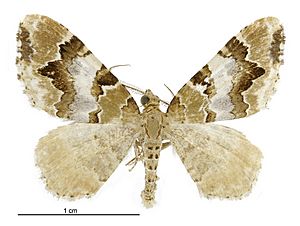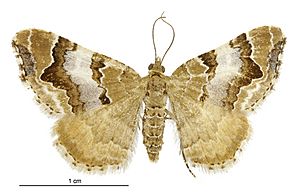Asaphodes obarata facts for kids
Quick facts for kids Asaphodes obarata |
|
|---|---|
 |
|
| Male | |
 |
|
| Female | |
| Conservation status | |
 Nationally Critical (NZ TCS) |
|
| Scientific classification | |
| Kingdom: | |
| Phylum: | |
| Class: | |
| Order: | |
| Family: | |
| Genus: |
Asaphodes
|
| Species: |
A. obarata
|
| Binomial name | |
| Asaphodes obarata (Felder & Rogenhofer, 1875)
|
|
| Synonyms | |
|
|
Asaphodes obarata is a moth in the family Geometridae. It is endemic to New Zealand. It is classified as critically endangered by the Department of Conservation.
Contents
Taxonomy
This species was first described by Cajetan Felder and Alois Friedrich Rogenhofer in 1875 as Cidaria obarata. The holotype specimen was collected by Thomas R. Oxley in Nelson and is held at the Natural History Museum in London. Edward Meyrick placed the species within the genus Larentia in 1884. In 1898 George Vernon Hudson placed the species within the genus Xanthorhoe. In 1971 John S. Dugdale assigned Xanthorhoe obarata to the genus Asaphodes.
Description
Hudson described A. obarata as follows:
The expansion of the wings is barely 1 inch. The fore-wings are pale greyish-ochreous ; there is an interrupted reddish-brown transverse band near the base ; two faint, interrupted shaded blackish hues, one at about one-third and the other at about two-thirds, enclosing between them a large central area, which contains a very distinct black dot above the middle, and several irregular shaded black marks; beyond this there is a wavy reddish-brown band; the apex of the wing is somewhat projecting, and the termen is considerably bowed. The hind-wings are pale grey, with a paler central band, and numerous faint, wavy, darker grey lines. The cilia of all the wings are white, banded with dark grey.
Distribution
A. obarata is endemic to New Zealand. As well as Nelson, it has been collected in Wellington, Christchurch and at the foot of Mount Hutt. It has also been collected at Waimarino and Ohakune in the North Island as well as Akaroa, Otira, Dunedin, Queenstown and Invercargill in the South Island.
There has been a contraction of range in Dunedin and Southland and this species is now regarded as being locally extinct in both Dunedin and Invercargill.
Ecology and habitat
Hudson states that this species could be found on the margins of forests and R. W. Fereday communicated that it was a plain-frequenting species that has an affinity for gorse hedges. Hudson also stated that adult moths were on the wing in December and January.
Host plants
The host plants of this species are unknown.
Conservation status
This moth is classified under the New Zealand Threat Classification system as being Nationally Critical. It has been hypothesised that this species is under threat as a likely result of habitat loss.
Images for kids


